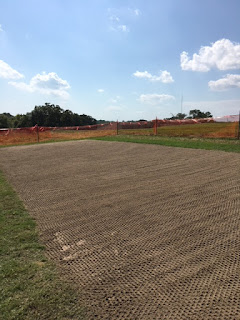Remember, remember, the snow of November!
Swope is covered in a blanket of snow and we are still a month away from the official start of Winter. Imagine that, crazy weather happening in KCMO. The sight of our course sheathed in snow is a beautiful sight and a welcome drink for our turf before it completely shuts down for the winter. As the grass is going dormant, we were able to get a couple housekeeping, well, course-keeping, tasks done for the upcoming winter.
Snow is a great insulator and source for moisture. As the winter goes on, and the turf growth will come to a halt, and whatever nutrients the plant has is what it will survive with until the Spring thaw. In early November we fertilized our green banks and the entire rough areas on the course. Think of it as a bear stuffing himself full of food before he goes to sleep for the winter. The plant absorbs every available nutrient as it can before taking a long winter 'nap'.
Using a Lesco Spreader for fertilizing areas around greens. (Top)
Our Vicon large area spreader for fertilizing the large rough areas. (Bottom)
Along and somewhat opposite with fertilizing, we sprayed our greens with a growth regulator. Our greens are Poa Annua (annual bluegrass). This type of turf will sprout seed heads in the spring, making for a bumpy and unattractive putting service. Getting the growth regulator in now and once more after the thaw, the plant should be free of seed heads coming prime time golfing season. Fertilizer was also applied along with the growth regulator.
Spraying 17 green.
Preperation is key with colder weather approaching. It's not just about the chemical and metabolic processes of the turf, but physical course attributes that need attention too. We keep carts on path only for as long as we can once it cools down to relieve as much stress on the turf as we can before dormant season. Tee markers are removed from boxes to be re-painted and allow golfers to spread out play and hopefully avoid isolated damage from a single tee location. Course signage is also brought in for touching up. When the ground gets colder and starts to freeze, cutting fresh cups is impossible. Before that weather started, we cut winter cups on each hole. This allows us to be able to have a choice of two different pin locations per hole. Just in case winter brings playable weather, golfers will be able to have two different looks at each hole.
As winter begins, its time for our winter projects to begin: blowing out irrigation, opening up green complexes, plowing snow. It will be a busy and cold couple months out here, but we're looking forward to it.
Stay warm, fix your divots, and watch out for geese.































